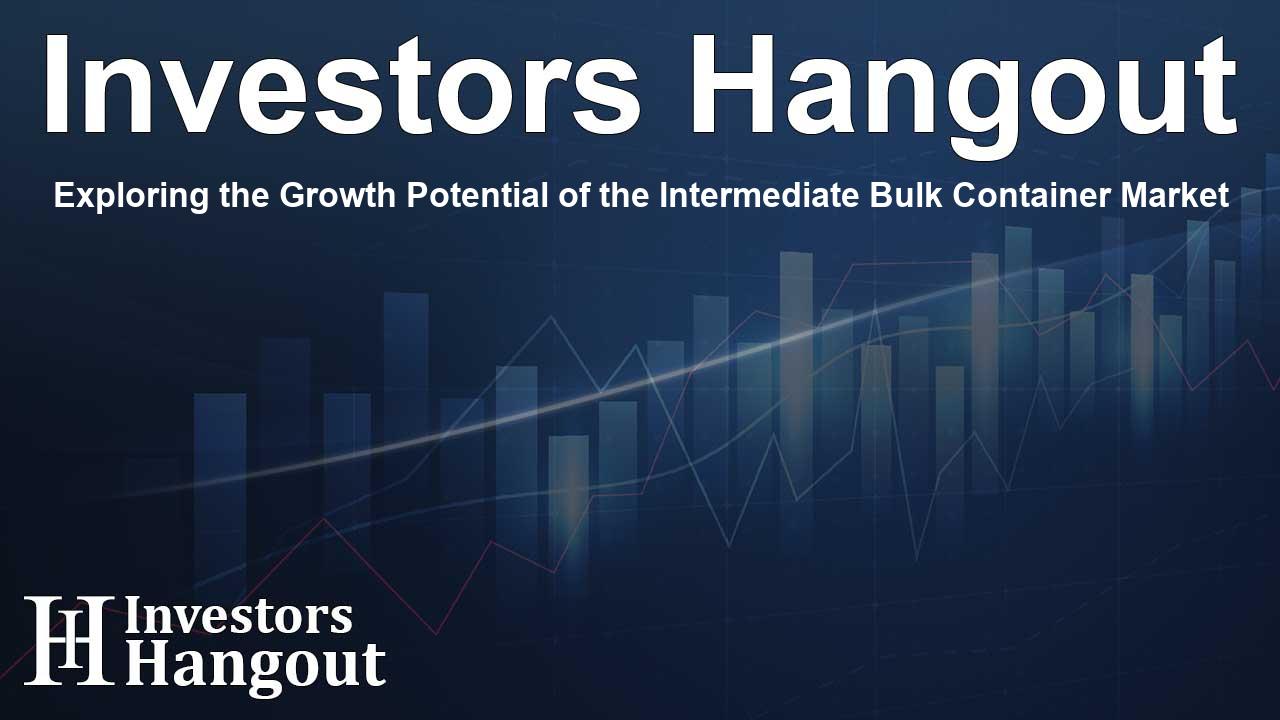Exploring the Growth Potential of the Intermediate Bulk Container Market

Intermediate Bulk Container Market Forecast and Dynamics
The Intermediate Bulk Container (IBC) market is positioned for remarkable growth, with expectations to reach a size of USD 23.35 billion by the end of the forecast period. This growth is projected at a compound annual growth rate (CAGR) of 5.80%, highlighting the increasing importance of IBCs across multiple industries.
Drivers Behind Market Growth
Several factors contribute to the momentum of this market, including the rising demand for efficient bulk packaging solutions. Industries such as pharmaceuticals, chemicals, and food and beverage are particularly driven by the need for secure and cost-effective storage solutions. IBCs are gaining traction due to their superior advantages over traditional packaging methods, optimizing space and enhancing delivery efficiency. For instance, a single IBC can replace multiple drums, leading to significant improvements in logistics efficiency.
Expanding Global Trade
The increase in international trade has amplified the demand for durable and sustainable packaging solutions. IBCs are designed for international shipping, making them the preferred option for businesses focused on logistics and supply chain management. Their ability to transport both liquids and solids makes them versatile for various applications, enhancing their market appeal.
Regulatory Compliance and Safety Standards
As industries handle more sensitive materials, compliance with safety regulations becomes crucial. IBCs are engineered to meet strict guidelines, ensuring safe transportation of hazardous materials. This adherence to safety standards, including certifications from regulatory bodies, positions them as a trusted choice in the market.
Sustainability Trends
With growing environmental concerns, there is an increasing shift towards sustainable packaging solutions. IBCs offer a recyclable and reusable option compared to single-use alternatives. By utilizing materials like high-density polyethylene (HDPE) secured in robust cages, IBCs support sustainable practices and contribute to a circular economy.
Technological Innovations in IBCs
The market for IBCs is further being shaped by technological advancements. The introduction of smart IBCs integrated with IoT sensors facilitates real-time monitoring and enhances inventory management. As these innovations continue to evolve, they are expected to provide valuable data insights for businesses, promoting efficiency and cost-savings throughout the supply chain.
End-User Industry Growth
The demand from key sectors like chemicals, food processing, and pharmaceuticals significantly influences the IBC market. Manufacturers in these industries rely heavily on IBCs for transporting products safely and efficiently. The increased focus on online grocery services and convenience foods drives the necessity for bulk transport solutions, enabling manufacturers to meet consumer demands effectively.
Challenges in the Market
Despite favorable growth prospects, the IBC market faces several challenges. One of the primary issues is the high initial cost associated with IBCs, posing a barrier for smaller businesses. Furthermore, logistical considerations for cleaning and reusing containers can complicate processes, particularly in industries dealing with hazardous materials.
Market Opportunities
Emerging economies present significant opportunities for expanding market presence. Countries in regions experiencing rapid industrial growth, such as Asia-Pacific and Latin America, are investing in sustainable packaging solutions. IBC manufacturers that adapt to the unique needs of these regions stand to capture a larger market share by providing customized solutions.
Competitive Landscape
The IBC market is characterized by intense competition, with several key players focused on innovation and sustainability. Strategic partnerships, acquisitions, and the implementation of smart tracking technologies are common practices among top manufacturers. Such collaborations are essential in maintaining a competitive edge while meeting the evolving demands of end-use industries.
Conclusion
The Intermediate Bulk Container market is on a path of dynamic growth driven by multiple factors, including regulatory compliance, technological advancements, and sustainability trends. As the demand for effective bulk packaging solutions persists, businesses must remain adaptable to capitalize on emerging opportunities in this enriching market landscape.
Frequently Asked Questions
What is the projected market size for Intermediate Bulk Containers by 2032?
The Intermediate Bulk Container market is expected to reach USD 23.35 billion by 2032.
What industries are driving demand for IBCs?
The pharmaceutical, chemical, and food and beverage industries are key drivers of demand for Intermediate Bulk Containers.
How do IBCs compare to traditional packaging methods?
IBCs are more space-efficient and cost-effective compared to traditional packaging methods, allowing for better product handling and logistics.
What constraints does the IBC market face?
The market faces challenges such as high initial costs, cleaning limitations for contaminated applications, and logistical hurdles for reuse.
What innovations are emerging in the IBC market?
Technological advancements like smart IBCs with IoT capabilities are enhancing supply chain efficiency and monitoring accuracy.
About The Author
Contact Ryan Hughes privately here. Or send an email with ATTN: Ryan Hughes as the subject to contact@investorshangout.com.
About Investors Hangout
Investors Hangout is a leading online stock forum for financial discussion and learning, offering a wide range of free tools and resources. It draws in traders of all levels, who exchange market knowledge, investigate trading tactics, and keep an eye on industry developments in real time. Featuring financial articles, stock message boards, quotes, charts, company profiles, and live news updates. Through cooperative learning and a wealth of informational resources, it helps users from novices creating their first portfolios to experts honing their techniques. Join Investors Hangout today: https://investorshangout.com/
The content of this article is based on factual, publicly available information and does not represent legal, financial, or investment advice. Investors Hangout does not offer financial advice, and the author is not a licensed financial advisor. Consult a qualified advisor before making any financial or investment decisions based on this article. This article should not be considered advice to purchase, sell, or hold any securities or other investments. If any of the material provided here is inaccurate, please contact us for corrections.
